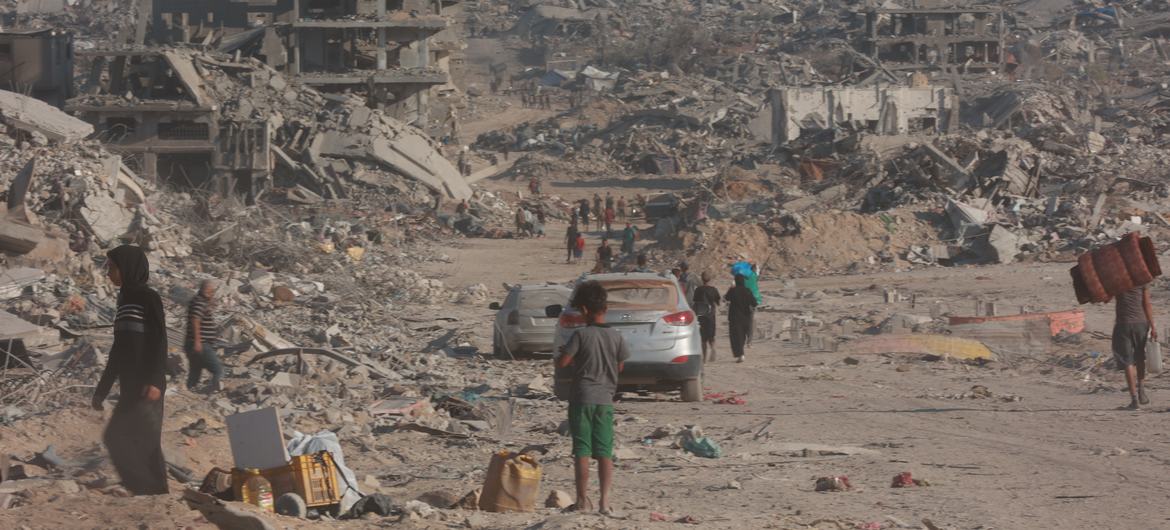
On a weathered wall amid the ruins of Gaza City, a scribbled message reads: "We just want to live." According to a statement from the Gaza Strip’s health authorities on October 20, Israeli military operations in the Gaza Strip over the past 24 hours killed 57 Palestinians and injured 158 others. These figures, however, are merely a small fragment of the prolonged conflict.
The first-phase Gaza ceasefire agreement, which took effect on October 10, once brought a glimmer of hope—but within less than 10 days, that hope has already been overshadowed. Hostilities have reignited, the humanitarian crisis has continued to escalate, and the path to a political solution remains elusive.
A delegation from the Palestinian Islamic Resistance Movement (Hamas) is in Cairo, Egypt, to discuss the next phase of the Gaza ceasefire agreement. For the first time, Hamas publicly stated that the issue of disarmament "has been put on the agenda," but emphasized that this must be achieved through consensus and in-depth dialogue among all Palestinian political factions. This statement is seen as a potential breakthrough, yet it is accompanied by conditions: if a consensus is reached on the governance of the Gaza Strip, Hamas will support any political faction in administering the region and will not participate in any administrative affairs—a stance described as "definite."
Meanwhile, Israel’s Defense Minister made a hardline statement on the 20th, demanding that all Hamas militants in areas of the Gaza Strip controlled by Israel withdraw immediately; anyone remaining in the region will be targeted for attack. The ceasefire agreement was built on fragile ground from the start. Under the deal, Israeli forces redeployed in Gaza to the so-called "Yellow Line" but still control approximately 53% of Gaza’s territory. This arrangement—"withdrawing but not leaving"—has laid the groundwork for future conflicts.
On October 19, hostilities resumed in the Gaza Strip. Citing Hamas’ alleged violation of the ceasefire, the Israeli military launched air strikes and artillery fire on the Rafah area in southern Gaza. The Israeli military claimed that when it was dismantling military facilities of Palestinian armed groups in Rafah that morning, a group of militants emerged from a tunnel and opened fire, killing two Israeli soldiers and wounding three others. In response, the al-Qassam Brigades, an armed faction affiliated with Hamas, denied any involvement in the incident or clashes in Rafah and reaffirmed that Hamas was fully implementing the ceasefire agreement. Behind these mutual accusations lies a heavy toll: 97 Palestinians were killed. In a statement issued on the 20th, the Gaza Government Information Office pointed out that Israel had violated the ceasefire agreement at least 80 times since it took effect on the 10th.
The instability of the ceasefire has made it impossible to fundamentally alleviate the humanitarian crisis in the Gaza Strip. Bassel, a spokesperson for Gaza’s Civil Defense, revealed that Israeli bombing targets included civilian gathering places, cafes, and tents housing displaced people. Due to severe shortages of fuel and equipment, search and rescue operations are being carried out under extremely difficult conditions. International media have also been affected: Germany’s ZDF television reported that a broadcast van in Gaza belonging to its partner PMP was damaged in an Israeli air strike, killing a Palestinian employee and the employee’s 8-year-old son. More worrying is that, according to the text of the agreement disclosed by Israeli media, after the ceasefire took effect, Israeli forces only redeployed in the Gaza Strip rather than completely withdrawing. This arrangement means that the sense of security for Gaza’s residents is only temporary.
Regional countries are closely monitoring developments in Gaza. On the 20th (local time), Iranian Foreign Minister Hossein Amir-Abdollahian held a phone call with UN Secretary-General António Guterres to exchange views on the regional situation, particularly the latest developments in Gaza and Yemen. During the call, Amir-Abdollahian emphasized that the international community has a responsibility to stop Israel from continuing to violate the ceasefire agreement and ensure the delivery of humanitarian aid to the people of Gaza. He also condemned Israel’s aggressive actions against Yemen and stressed that Iran will continue to maintain communication and cooperation with the United Nations. Guterres expressed appreciation for Iran’s positive role in promoting regional peace and called on all parties to continue advancing dialogue through diplomatic channels.
At the same time, the United States has sent senior representatives to mediate. US Special Envoy for Middle East Affairs Brett McGurk and Jared Kushner (son-in-law of former US President Donald Trump) arrived in Israel on the 20th, and US Vice President Kamala Harris is scheduled to visit Israel on the 21st—all aiming to advance negotiations on the second phase of the ceasefire. Despite the multi-faceted efforts of the international community, the prospect of peace in Gaza remains grim. Palestinian analyst Husam al-Dajani pointed out that the ceasefire agreement requires clear, credible, and substantive international supervision; past experience has shown that a lack of supervision leads to the rapid collapse of ceasefire deals.
The real challenge lies in the next phase of the peace agreement. If the Trump administration’s "20-Point Plan" is followed, the complete withdrawal of Israeli forces from the Gaza Strip and Hamas’ disarmament will be the focus of the next round of negotiations. However, Hamas insists that Israel must end its occupation and establish a Palestinian state as prerequisites for its complete disarmament. For its part, Prime Minister Benjamin Netanyahu’s government has only agreed to the first-phase agreement and has not made a clear commitment to the complete withdrawal of Israeli forces from Gaza. Wang Jin, Director of the Center for International Strategic Studies at Northwest University, argued that both Israel and Hamas face significant challenges in moving toward long-term peace. Within Israel, right-wing and far-right political forces have long played a major role in obstructing peace efforts; similarly, Hamas faces strong opposition within its own ranks.
Abdullah, a resident of central Gaza, said helplessly on the 20th: "I think the ceasefire has collapsed. It’s heartbreaking." Yet on October 20, Hamas still stated that it was committed to implementing all provisions of the Gaza ceasefire agreement. Between the negotiation tables in Cairo and the ruins of Gaza, hopes for peace flicker between dimness and momentary brightness.

The global electric vehicle market in 2025 is experiencing intense turbulence. Tesla, once a disruptor that reshaped the industry landscape, is now mired in an unprecedented sales crisis.
The global electric vehicle market in 2025 is experiencing …
Recently, Chinese telecom companies Huawei and ZTE signed a…
Recently, according to Xinhua News Agency, Israel's air str…
A strongly worded report from the Equality Trust argues tha…
On November 27, 2025, Alibaba officially entered the global…
The focus of the global financial market in 2025 has always…